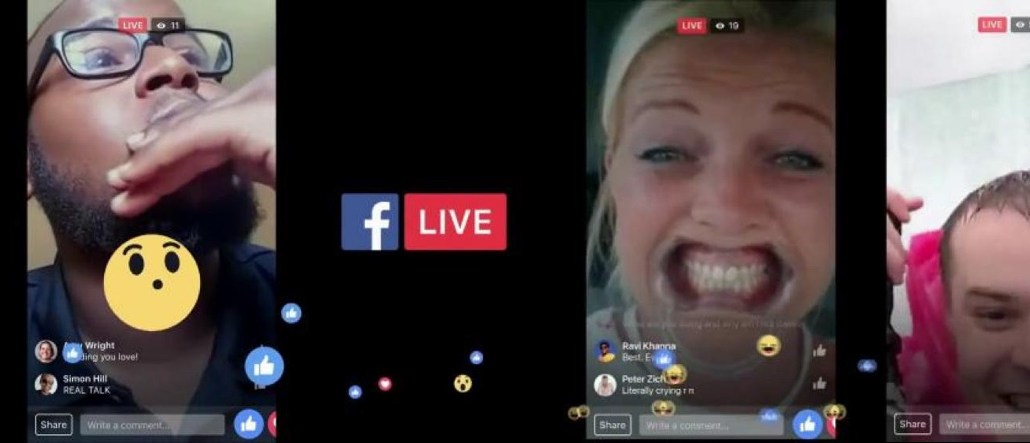Save 50% on a 3-month Digiday+ membership. Ends Dec 5.

Facebook might have over a billion daily active users. But in an attempt to drive mass adoption of Facebook Live, it has turned to TV, becoming a major advertiser there in the process.
Last month, the company launched the largest TV-advertising campaign in its history, airing over 20 different commercials more than 1,700 times, and it wasn’t exactly airing them between infomercials: Ads for Facebook Live have run during the 2016 World Series, as well as numerous NFL Sunday and nationally televised college football games. Facebook has spent enough on the spots – an estimated $16.4 million, according to iSpot.tv – to vault itself into the top-70 biggest-spending advertisers on TV over this period.
That investment blows past the $14.1 million Facebook spent advertising on digital media through the first half of 2016, according to Kantar data; the total amount of money Facebook’s spent advertising on digital over that period is close to flat year-over-year.
“TV buys are innately accompanied by a sense of comfort and clout,” said Evan Walker, a media supervisor at GSD&M. “There is no doubt that TV brings mass reach and drives awareness.”
The TV buy might be an expensive lever, but it’s hardly the only one Facebook has pulled to promote Live. It invested $50 million in yearlong contracts with some 140 celebrities and publishers to produce Facebook Live content, agreements that yielded an exploding watermelon and a man trying to destroy a vase.
It also quietly began testing ads that would allow brands and publishers to promote Live content in readers’ news feeds at the moment of the broadcast.
Facebook is not the only platform to spend money to promote its features on TV – Twitter shelled out for a Moments campaign last year – and it has done product-specific TV ad campaigns before. It has also run numerous brand campaigns on TV, including some heartstring-tuggers produced by agencies including Wieden + Kennedy Portland and Whirled. Its own in-house production agency, The Factory at Facebook, has in the past tapped top-shelf directors including Mike Mills (“Thumbsucker”) for campaigns.
But Facebook is investing substantially at a time when Facebook and Instagram, which it also owns, are pushing hard to build audience for its video products. Facebook needs more people to go live not only because growing video consumption is the only way it can increase ad load but also because it continues to feel heat from Snapchat, which was producing upwards of 10 billion video views per day this summer, despite having an audience barely a tenth the size of Facebook’s.
“Facebook is losing market share within the younger demographic to Snapchat,” said Andrew Gerhart, the COO of mobile video ad exchange AerServ, said of Facebook’s motivation for investing in TV advertising. Facebook’s full-court advertising press, he said, “is the response to the rise in popularity of the same type of video production and consumption on Snapchat, and their desire to have users produce video content and drive more video views.”
Facebook Live is only a couple months old, and everybody, from its regular users to its top media agencies, is still figuring out how to use it. But after a quick surge of people trying Live out when it debuted in April, growth in the number of Facebook accounts using the Live feature began slowing down this summer, growing 2 percent to 529,000 accounts in June, according to data from Tubular Labs. It’s unclear whether this trend has continued; a spokesperson from Tubular said the company was unable to provide more current data.
More in Media

AI-powered professional learning and the battle vs. ‘workslop’: Inside Deloitte’s Scout
Deloitte last month launched Scout as part of its Project 120, the company’s $1.4 billion investment in professional development.

‘The Big Bang has happened’: Reach gets proactive on AI-era referrals, starting with subscriptions
This week, the publisher of national U.K. titles Daily Mirror, Daily Express and Daily Star, is rolling out its first paid digital subscriptions – a big departure from the free, ad-funded model it’s had throughout its 120-year history.

Arena Group, BuzzFeed, USA Today Co, Vox Media join RSL’s AI content licensing efforts
Arena Group, BuzzFeed, USA Today Co and Vox Media are participating in the RSL Collective’s efforts to license content to AI companies.








